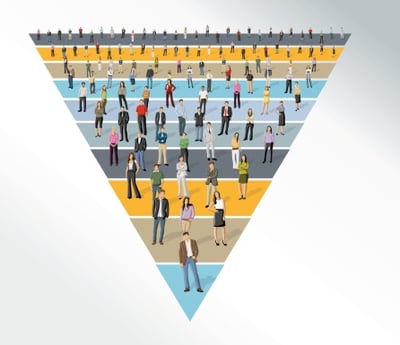 Vorsight reports that at any given time, only 3% of your market is actively buying, 56% are not even looking and 40% are just beginning. This is a great statistic to help new inbound marketing clients understand why most of their leads are top of the funnel leads.
Vorsight reports that at any given time, only 3% of your market is actively buying, 56% are not even looking and 40% are just beginning. This is a great statistic to help new inbound marketing clients understand why most of their leads are top of the funnel leads.
This data also supports the need to make sure your inbound marketing programs include some form of targeted outreach to handle the 56% of the people who are good prospects but have not even started their buyer journey.
Here are some techniques you can use to help educate people new to inbound, to keep educating your clients while your program gains traction and to make sure they don’t get frustrated when they see leads but only a handful of sales ready leads.
Make Sure You Collaborate On Lead Stage Definitions
Almost every company has a different definition of what a lead is and what a lead is not. This probably isn’t going to come up in the sales process, so defining it before you get started with the inbound marketing planning effort is critical.
What does a marketing qualified lead look like? What’s a sales qualified lead? What’s a sales opportunity? What do we call the stage when the prospect has paperwork? Are we using any lead scoring to segment leads? Are we agreeing that the marketing is going to focus on generating leads up and down the funnel? You have to have these, sometimes rough, conversations with clients up front.
You have to make sure they’re taking your input into consideration as you come up with an agreed on definition. Regardless of what you come up with you can then structure your inbound program and inbound tactics accordingly.
If you’re looking for guidance, my recommendation would be anyone who completes any form on your client’s site (except resume submission) is a lead. Marketing qualified leads are typically top of funnel leads. I’d probably consider most middle of the funnel offers to also produce MQLs, it’s not until you get down to bottom of the funnel offers do you need sales involvement, so these are typically what we consider sales qualified leads. Not because sales qualified them, but because prospects are ready to talk to a sales person.
Of course all SQLs won’t be ready to buy, so the next stage would be sales opportunities for those that both sales agrees are qualified and for prospects who want to get into an active sales process. Within the sales process you might have some different stages, but the next real progression is from sales opportunity to proposal or recommendations or contracts submitted and then you have close or no close. This all might seem extremely straight forward, but I’ve seen huge companies need a lot of help working this all out. Don’t think anyone has this down.
Help Them With A Process For Following Up With Leads
Again, don’t assume (even if they tell you they’re good) that your clients know how to handle new inbound leads. You should be working with them very early in your engagement to make sure they know what to do when they get a top, middle or bottom of the funnel lead.
The answer might be nothing, like in the example of a top of funnel leads. If lead nurturing workflows are in place, sales people may be able to simply monitor the prospect’s interaction with lead nurturing emails and that’s it, but that should be discussed.
What if the prospect returns to the website? What if they view a key buying page or a bottom of the funnel page like pricing? Has the lead been assigned? Who should be contacting the prospect? Do you even want someone contacting them? Working it all out upfront puts your engagement in a much better position to be successful.
Highlight Data From Workflows That Produce Bottom Of The Funnel Leads
 Lots of time the leads at the top and middle of the funnel get lost while all the attention is on bottom of the funnel and sales opportunities. However, the long term health of the pipeline lies in having good numbers at all levels. This assumes that top and middle of the funnel leads are actually working their way down and into the bottom. To know this for sure, you have to track the progress of leads through the funnel.
Lots of time the leads at the top and middle of the funnel get lost while all the attention is on bottom of the funnel and sales opportunities. However, the long term health of the pipeline lies in having good numbers at all levels. This assumes that top and middle of the funnel leads are actually working their way down and into the bottom. To know this for sure, you have to track the progress of leads through the funnel.
For instance, a new bottom of the funnel leads is great, but a top of funnel lead who comes back and converts on a bottom of the funnel offer is even better. It means you’re proactively offering the right mix of information to pull prospects through the funnel.
Remember the data above, 97% of the people are NOT ready to buy. Capturing the ones who are ready to buy should be easier than getting everyone else to realize your client has something of value that they really need to consider. Use data to educate your clients. This nurturing effort is a big part of inbound marketing and one that gets missed a lot.
Start With Conservative Estimates For Lead Goal Projections
When we look at data across all our clients, we see about 10% of the leads are bottom of the funnel leads but I’m actually happy to see the Vorsight data show 3% because that technically gives me a chance to underestimate and over deliver.
Often we try to make a compelling business case for marketing return on investment and this bottom of the funnel conversion metric is a great place to pump up the volume. But you might want to resist the urge to do that. If the client has unrealistic expectations on the performance of the program you might be in trouble before you even get a chance to drive real program performance.
I’d rather see you be conservative, let the client know this is conservative and as you get actual client data adjust the projections. This approach also points out to the client that a longer term perspective produces much more dramatic results. Year two, for example, is always a more interesting view of the program than the first six months, while you’re still getting all the inbound assets together.
Again, in a world of instant gratification, this is an important conversation to have early in your new client relationship.
This is a lot of work and for most agencies and I don’t see this getting done. Clients want to jump right in and start writing, redoing websites, creating pages, sending emails and posting to social media. Resist the urge to be pushed by your clients. The result is just going to be programs that disappoint and difficult conversations about who told who to do what.
Instead, start with strategic conversations. Make sure they understand the expectations around leads and specifically bottom of the funnel leads.
Start Today Tip – Build into your engagement a session on “what is a lead?” Specifically, create the definitions with your client and create some conversion metric expectations to use as a benchmark for their initial inbound funnel analysis. This helps them see that leads they do get are not working through the funnel and once you start nurturing those leads, your client should see a quick win as that lead conversion rate starts to tick up. Also, if you set a low expectation on the bottom of the funnel lead flow and you can exceed those expectations with solid bottom of the funnel offers, you’ll look like an inbound marketing superstar.
 The Mastermind Group has only a few seats left. If you're interested in getting into this dynamic, issue processing group where you get actionable takeaways in every session, cick on the box to grab your seat today!
The Mastermind Group has only a few seats left. If you're interested in getting into this dynamic, issue processing group where you get actionable takeaways in every session, cick on the box to grab your seat today!
Agencies 2 Inbound – Helping You Go ALL IN ON Inbound!

